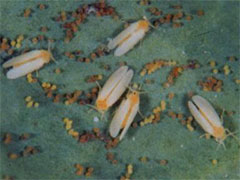Florida Tomato Scouting Guide
- Insect and Related Animals Identification Key
- Insect Leaf Damage Decision Key
- Insect Fruit Damage Decision Key
- Disease Identification Key
- Insect Bio-capsules
- Disease Bio-capsules
How to use the Identification Keys
What is an "identification key?" It is a road map of sorts that aids in the identification of a disease or an insect specimen observed in the field. It is based on a series of questions that have as answers choices between two or more alternative pathways. The choices describe symptoms or morphological characteristics thought to be most distinctive of a particular insect or disease.
In order to use these keys, you must first decide or make an educated guess as to whether the damage or symptom is caused by an INSECT or DISEASE. If an insect is suspected or found on or around the plants, you can go directly to the Insect and Related Animals Identification Key. If no insects are observed, but insect damage is suspected because of holes, mines, punctures, or in some cases, dimples on the leaves or fruit, go directly to the Insect Leaf Damage Decision Key or the Insect Fruit Damage Decision Key, as appropriate. If a disease is suspected, go directly to the Disease Identification Key. The queries will eventually lead you to the appropriate "bio-capsule" which gives condensed biological information for each insect or disease. Life cycle and damage descriptions for insects are given, as are additional symptoms and descriptions of environmental conditions favorable for diseases. Select Insect Bio-capsules or Disease Bio-capsules for listings of those used in this program.
This online guide replaces the print version of IFAS Publication No. SP-22, Florida Tomato Scouting Guide with Insect and Disease Identification Keys, second edition. The purpose of the Guide is to assist scouts in identifying insects and diseases commonly encountered in monitoring tomato fields in Florida. This information was developed for the Growers by Dr. Ken Pernezny.
 MENU
MENU